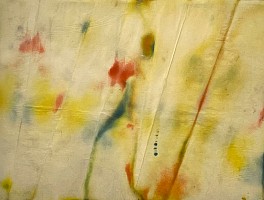BIOGRAPHY

American (1933-2022)
Sam Gilliam is one of the great innovators in postwar American painting. He emerged from the Washington, D.C. scene in the mid-1960s with works that elaborated upon and disrupted the ethos of Color School painting. Gilliam was the first African-American artist to represent the U.S. at the Venice Biennale, in 1972.
Gilliam was born in 1933 in Tupelo, Mississippi. He moved with his family to Kentucky as a child, and he graduated from the University of Louisville with his bachelor’s degree in 1955. Already a promising artist, he had his first solo exhibition that year at the University. Gilliam went on to receive his MFA from the University of Louisville in 1961.
Gilliam established himself at the forefront of American abstraction while working in Washington, D.C. in the 1960s, when his experiments with paint application and his radical transformation of the canvas support profoundly expanded the possibilities for the future of abstract painting. Working alongside Color Field painters such as Kenneth Noland and Thomas Downing, Gilliam elaborated upon Color Field processes and aesthetics while subverting Greenbergian notions of the “integrity of the picture plane,” and disrupting the boundaries between the visual world of painting and the tangible world outside it.
At a time during the Civil Rights movement, when African American artists were expected by many to create figurative work explicitly addressing racial subject matter, Gilliam persisted in pursuing the development of a new formal language that celebrated the cultivation and expression of the individual voice and the power of non-objective art to transcend cultural and political boundaries.
In addition to a traveling retrospective organized by the Corcoran Gallery of Art, Washington, D.C. in 2005, Sam Gilliam has been the subject of solo exhibitions at the Museum of Modern Art, New York (1971); The Studio Museum in Harlem, New York (1982); Whitney Museum of American Art, Philip Morris Branch, New York (1993); J.B. Speed Memorial Museum, Louisville, Kentucky (1996); Phillips Collection, Washington, D.C. (2011); and Kunstmuseum Basel, Switzerland (2018), among many other institutions. A semi-permanent installation of Gilliam’s paintings will opened at Dia:Beacon in August 2019. His work is included in over fifty public collections, including those of the Musée d’Art Moderne de la Ville de Paris; Tate Modern, London; the Museum of Modern Art, New York; the Metropolitan Museum of Art, New York; and the Art Institute of Chicago. He lives and works in Washington, D.C.
